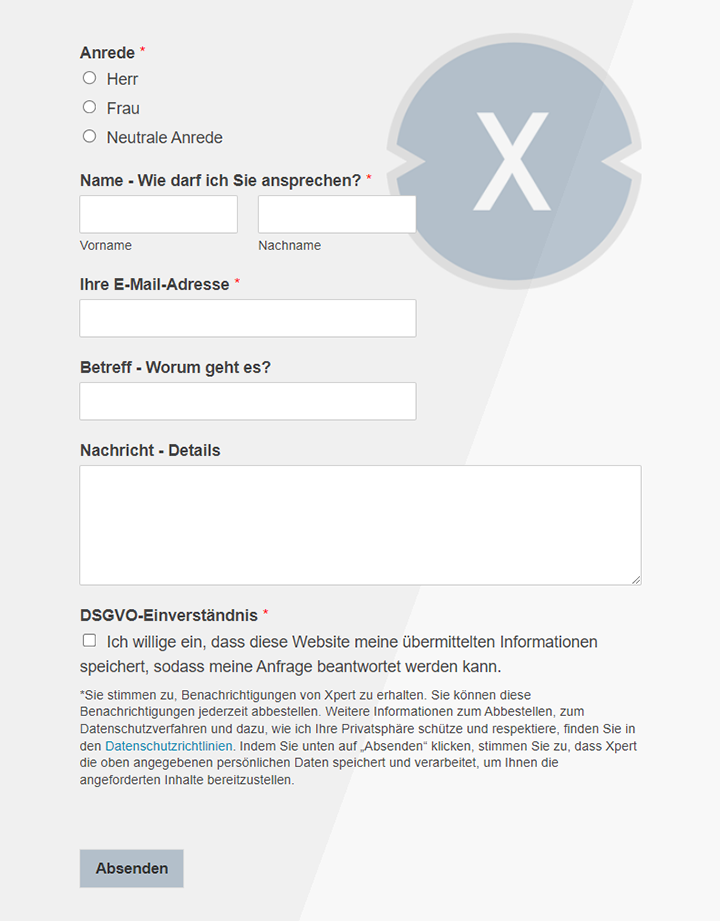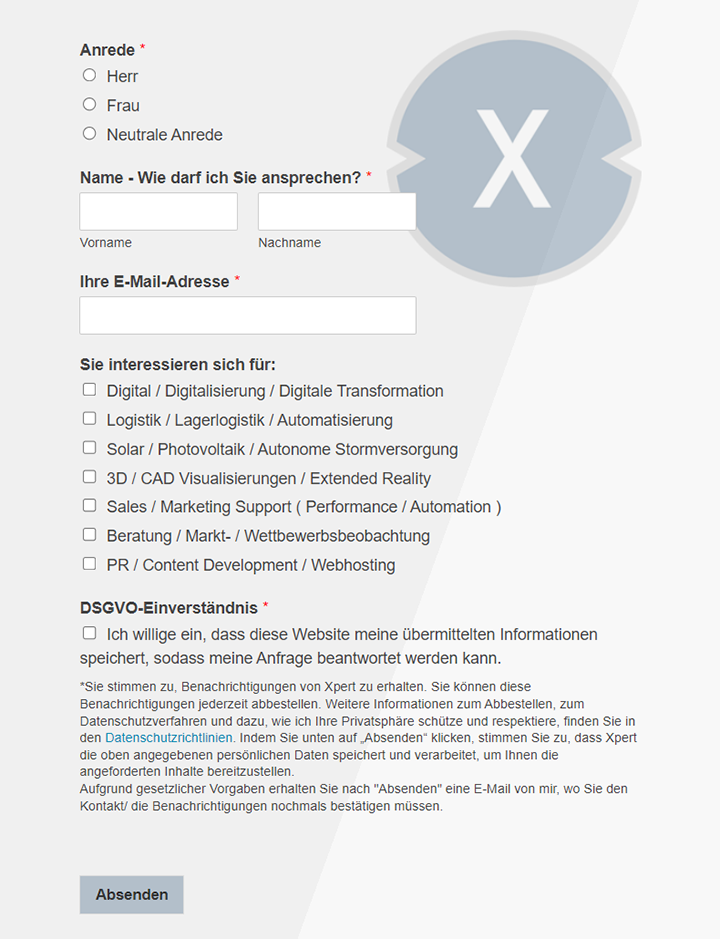The challenge of Europe: why US cars are not very well received on the old continent and what has to change
Xpert pre-release
Language selection 📢
Published on: April 4, 2025 / update from: April 4, 2025 - Author: Konrad Wolfenstein

The challenge of Europe: Why US cars are not very well received on the old continent and what has to change-Image: Xpert.digital
Low sales figures for US cars: causes research -
European car market: Where the problems for US manufacturers begin-analysis of the low sales figures for US cars in Europe
The European automotive market is a highly competitive battlefield on which established European manufacturers, ambitious international brands and disruptive newcomers argue for the favor of buyers. In this environment, American automobile manufacturers traditionally have a hard time gaining a foothold. While Ford is a remarkable exception with its strategy tailored to Europe, and Tesla has recently caused a sensation as a pioneer in the electromobility sector, many other US brands with low sales figures and a limited market share are fighting.
But even Tesla, once celebrated as the hope for US cars in Europe, is increasingly faced with challenges. A decline in sales raises questions as to whether the initial success story will be permanent and whether factors that go beyond pure competition play a role.
This article illuminates the diverse reasons for the limited success of US cars in Europe. We analyze the differences in the infrastructure, the deviating design preferences, the strict regulatory requirements, the growing importance of sustainability, the complex competitive strategies and the deeply rooted cultural factors. We also take a special look at the changing situation of Tesla and the effects of the public persona of his CEO on the brand.
The infrastructure: a continent full of challenges for large cars
An essential factor that affects the preferences of European car buyers is the infrastructure. Compared to the extensive streets and spacious parking spaces in the USA, Europe presents itself with a road network that has grown historically and often offers tight roads and limited parking facilities.
Tight streets, tight curves: the challenge for large US cars
The European road network, especially in historical cities, is characterized by narrower roads and narrower curves. While American highways often have wide lanes designed for larger vehicles and higher speeds, European roads are often tighter and more curvy.
These differences in the street infrastructure have a direct impact on the preferred vehicle size. In narrow streets and on winding country roads, smaller, more agile cars have a clear advantage. The larger dimensions of many US cars, which are valued for comfort and space in the United States, quickly become a disadvantage in Europe. The maneuvering by narrow streets, parking in crowded cities and the general agility in dense traffic are becoming a challenge.
It is no coincidence that European cities tend to be more pedestrian and bicycle-friendly than American cities. The stronger dependence on public transport and the lower need to cover large routes by car also contribute to the preference for smaller vehicles.
Parkplatz albTraum: If centimeters decide
Another obstacle to US cars in Europe is parking space dimensions. Parking spaces in Europe are generally smaller than in the USA. This is a direct consequence of the lack of space in urban areas and the historical prevalence of smaller vehicles.
The average size of parking spaces in Europe is significantly below the US standards. The increasing breadth of even European cars means that parking spaces are scarce. The difficulties of parking larger vehicles can lead to urban overload and frustration among drivers.
This parking situation makes larger American vehicles more impractical in everyday life. If you are traveling regularly in the city, you will consider twice whether you buy a car that finds it difficult to park.
Design and equipment: a matter of taste and practical considerations
The design aesthetics and the features of US cars also often differ from the preferences of European car buyers. While US cars are often geared towards size, performance and comfort, European buyers value efficiency, maneuverability and an appealing design.
Size and body form: compact vs. spacious
US cars are generally larger and emphasize spacious interiors and powerful engines. Popular forms of body are large limousines, SUVs and pick-up trucks. European preferences tend to smaller, more agile vehicles such as slanted rear limousines, station wagons and compact SUVs, which are better suited for urban environments and often prioritize fuel efficiency.
This fundamental difference in the preferred vehicle size is based on a combination of infrastructure restrictions (narrower roads, smaller parking spaces) and cultural values (practicality, efficiency vs. spaciousness, performance). European manufacturers focus on smaller segments, while US manufacturers traditionally prioritize larger vehicles for their domestic market.
Design aesthetics: Kühn vs. refined
The design of US cars is often characterized by a bold, more impressive aesthetics with larger radiator grills and striking branding. European design, on the other hand, tends to a slimmer, more streamlined and more sophisticated look that emphasizes elegance and often integrates subtle details.
European consumers often prioritize subtle elegance and aerodynamic efficiency, while American consumers may appreciate a more confident and powerful visual statement. Design preferences are deeply rooted in cultural values and historical contexts.
Equipment and features: Security and quality in focus
US cars often offer generous standard equipment, possibly including more advanced air conditioning systems and larger engines. European cars, on the other hand, often have high -quality materials and a focus on safety and advanced driver assistance systems (ADAS).
European consumers may place a higher value on certain active security features and the overall finishing. While both markets prioritize security, the specific features and the time of their implementation can differ due to different regulatory requirements and consumer requests.
Regulatory hurdles: fuel efficiency and emissions in sight
European regulations and laws in relation to fuel efficiency and emission standards are generally stricter than those in the United States, which can be a challenge for US models.
Strict fuel efficiency standards
Europe has had historically stricter fuel efficiency standards than the United States, which is due to higher fuel prices and environmental concerns. The stricter European fuel efficiency regulations promote production and purchase of smaller, fuel -saving vehicles.
This is a challenge for the traditionally larger and less fuel-efficient US cars. US car manufacturers have to invest in technologies in order to adapt their vehicles to European standards.
Demanding emission standards
The European emission standards (euro standards) are generally stricter and more comprehensive than those in the USA (EPA standards). They often include limit values for a wider range of pollutants and non-exhaust emissions.
US car manufacturers face the challenge of adapting their vehicles to the stricter and often different emission standards in Europe. This requires significant technical modifications and may be able to restrict the models that you can offer.
Euro 7 vs. EPA: A race for clean air
The introduction of Euro 7, which includes non-exhaust gas emissions (brakes, tires) and stricter test conditions, represents a more comprehensive approach to vehicle pollution compared to the current US standards. While both regions are moving towards strict emissions, the focus and specific limit values differ. US car manufacturers are forced to invest in technologies that are tailored to the European regulatory landscape.
The green conscience: sustainability as a purchase argument
European consumers generally show a higher level of environmental awareness and prioritize sustainability in their purchase decisions, including cars. The pronounced environmental awareness in Europe creates a higher demand for fuel -efficient and low -emission vehicles, including hybrids and electric cars that have been developed and marketed more proactive by European manufacturers.
🎯🎯🎯 Benefit from Xpert.Digital's extensive, fivefold expertise in a comprehensive service package | R&D, XR, PR & SEM

AI & XR 3D Rendering Machine: Fivefold expertise from Xpert.Digital in a comprehensive service package, R&D XR, PR & SEM - Image: Xpert.Digital
Xpert.Digital has in-depth knowledge of various industries. This allows us to develop tailor-made strategies that are tailored precisely to the requirements and challenges of your specific market segment. By continually analyzing market trends and following industry developments, we can act with foresight and offer innovative solutions. Through the combination of experience and knowledge, we generate added value and give our customers a decisive competitive advantage.
More about it here:
Why American carmakers fall behind in Europe
The rise of electromobility
The demand for electrical and hybrid vehicles in Europe is growing rapidly, driven by environmental concerns, state incentives and an increasingly available charging infrastructure. US car manufacturers have to offer a convincing range of electrical and hybrid vehicles in order to operate growing demand in Europe. She has had its historically slower introduction of EV technology compared to European manufacturers who have been investing in this area for a long time.
State incentives as a catalyst
European governments actively promote the introduction of electric vehicles through various incentives, including subsidies, tax exemptions and investments in the charging infrastructure. This state support plays a crucial role in the design of consumer behavior and accelerating the switch to electric vehicles in Europe. US car manufacturers have to know the political framework and incentives in the various European countries and possibly stand up for guidelines that support their range of electric vehicles on the European market.
Tesla: A success story with dark sides
Tesla experienced an unprecedented ascent and quickly established himself as the leading player in the European electromobility market. The initial success was based on a combination of factors:
Innovative technology
Tesla's advanced battery technology, the large range and the over-the-air software updates positioned it as a leader in the area of electric vehicles.
Stylish design
Teslas minimalist and futuristic design language addressed some European buyers who were looking for a departure from traditional authenthetic.
Strong brand image
Tesla was perceived as a pioneer in the area of sustainable transport and addressed the environmentally conscious European market.
Elon Musk: From the visionary to the political issue
However, the wind for Tesla seems to be turning in Europe. The decline in sales figures indicates that the brand is confronted with new challenges. An essential factor could be in the person of Elon Musk himself.
Musk's increasing engagement in US politics and its support for right-wing parties in Europe have caused considerable controversy and counter-reactions in Europe. His increasingly polarizing public persona and his proximity to right -wing extremist ideologies seem to alienate a significant part of European consumers who tend to represent more progressive social and political views. This leads to a “brand crisis” for Tesla in Europe.
Reports indicate a significant decline in Tesla sales in important European markets, which coincides with the increased public control of Musk's political activities. It seems to give a clear connection between the increased visibility of Musk's controversy views and the significant decline in Tesla sales in Europe, which indicates that his persona is now negatively influencing the brand's attractiveness in this market.
Competition: a diverse landscape
The European automotive market is a highly competitive environment in which established European manufacturers, aspiring international brands and disruptive newcomers argue about the favor of buyers.
Diversity of the models
European car manufacturers offer a wide range of models in various segments, including numerous electrical and hybrid options that are tailored to the European taste and infrastructure. The broader and more diverse model range of European manufacturers, especially in the rapidly growing EV segment, offers European consumers more options that meet their preferences and needs. This puts US brands under pressure with a more limited offer.
Price strategies
European cars are often perceived as high -quality and technologically advanced and therefore sometimes achieve a higher price. US cars were historically positioned as affordable, although import costs and tariffs can increase their price in Europe. The pricing plays a crucial role on the European market, where consumers are often priced. US car manufacturers must carefully check their price strategies and take into account tariffs, competition and the perceived value of their vehicles compared to European and other international brands.
Marketing approaches
In their marketing, European automobile brands often emphasize tradition, performance, technology and sustainability. Marketing strategies must be culturally relevant and reflect the values and priorities of European consumers. US car manufacturers may have to adapt their messages to highlight aspects such as efficiency, technology and suitability for European driving conditions instead of relying on traditional USPs.
Cultural and historical characteristics: more than just technology
The low sales figures for US cars in Europe are not only due to technical or economic factors. Cultural differences and historical characteristics play an important role in the design of consumer preferences.
Car preferences: practicality vs. status symbol
Europeans tend to consider cars to be a practical means of transport and prioritize efficiency, maneuverability and suitability for urban environments. Americans often see cars as an expansion of their personality and a status symbol, with a preference for larger, more powerful vehicles.
These fundamental cultural differences in the perception and use of cars contribute significantly to the divergence of the vehicle preferences between the USA and Europe.
Brand loyalty and nationalism
European consumers often show strong loyalty to domestic automobile brands that are deeply rooted in their cultural identity and history. The strong brand loyalty to established European manufacturers is a significant barrier for US automobile brands who try to gain a foothold in this market. Overcoming this loyalty requires the offer really more convincing and differentiated products that reflect European values.
Historical presence and perception
European car manufacturers have built a long and established story in the region and a strong brand awareness and trust for decades. The historical successes and failures of US automobile brands in Europe have shaped consumer perception and brand awareness, which made it difficult to penetrate the market. The perception of some US brands as less refined or does not continue to be tailored to European needs.
Strategic considerations: A look into the future
The low sales figures for US cars in Europe are due to a complex combination of factors, including infrastructure restrictions, different design preferences, strict regulatory requirements, a strong focus on sustainability, intensive competition, the negative effects of Elon Musk's person on the Tesla brand and deeply rooted cultural and historical aspects.
For US car manufacturers who want to be successful in Europe, the following strategic considerations are of crucial importance:
Adjust design and size
Development and marketing of smaller, fuel -efficient vehicles that are specially tailored to European roads, parking spaces and urban environments.
Focus on sustainability
Prioritization of the development and offer of a comprehensive range of electrical and hybrid vehicles that meet European emission standards and address environmentally conscious consumers.
Master regulatory compliance
Investments in technology and technology to ensure the complete compliance with the strict European fuel efficiency and emission regulations, including the Euro 7 standards.
Refine marketing strategies
Development of cultural -sensitive marketing campaigns that highlight the practicality, efficiency, technology and security of their vehicles for the European market and possibly go beyond traditional USPs.
Build trust and fidelity
Investments in the long -term structure of brand awareness and trust through the focus on quality, reliability and customer service, whereby teaching from Ford's success may be drawn in Europe.
Tackle the “Musk factor” (for Tesla)
Recognize and potentially weaken the negative effects of Elon Musk's public persona on the brand image and the sales figures in Europe, possibly by focusing on marketing efforts on vehicle technology and environmental advantages.
Consider local production or partnerships
Checking the establishment of local production facilities or strategic partnerships in Europe to reduce import costs, bypass tariffs and better use the regional preferences.
The European automotive market is complex and requires a differentiated and strategic approach so that US car manufacturers can be successful. It is not enough to simply export US models to Europe. Rather, it is necessary to understand and respond to the specific needs, preferences and regulatory framework conditions of the European market. This is the only way to gain a foothold in Europe and be successful in the long term.
We are there for you - advice - planning - implementation - project management
☑️ SME support in strategy, consulting, planning and implementation
☑️ Creation or realignment of the digital strategy and digitalization
☑️ Expansion and optimization of international sales processes
☑️ Global & Digital B2B trading platforms
☑️ Pioneer Business Development
I would be happy to serve as your personal advisor.
You can contact me by filling out the contact form below or simply call me on +49 89 89 674 804 (Munich) .
I'm looking forward to our joint project.
Xpert.Digital - Konrad Wolfenstein
Xpert.Digital is a hub for industry with a focus on digitalization, mechanical engineering, logistics/intralogistics and photovoltaics.
With our 360° business development solution, we support well-known companies from new business to after sales.
Market intelligence, smarketing, marketing automation, content development, PR, mail campaigns, personalized social media and lead nurturing are part of our digital tools.
You can find out more at: www.xpert.digital - www.xpert.solar - www.xpert.plus


























